Persuasive Features that Drive the Adoption of a Fitness Application and the Moderating Effect of Age and Gender
Abstract
1. Introduction
2. Background and Related Work
2.1. Definition of Persuasive Features
2.2. Gender and Age Differences
2.3. Captology and Persuasive Technology
2.4. Relationship between Persuasive Features and Intention to Use/Actual Use
2.5. Related Work on Relationship between Persuasive Features and Intention to Use/Actual Use
3. Method
3.1. Research Questions
- RQ1.
- Can persuasive features predict users’ intention to use a fitness app?
- RQ2.
- Which of the six commonly employed persuasive features is/are the strongest predictors of users’ intention to use a fitness app?
- RQ3.
- How do gender and age moderate the interrelationships among the persuasive features and users’ intention to use a fitness app?
3.2. Storyboards
3.3. Measurement Instruments
Imagine you want to improve your personal health and fitness level. Given the challenges (e.g., time, cost, weather, etc.) associated with going to the gym regularly, the “Homex App” has been created, say by health promoters in your neighborhood, to support your physical activity.
3.4. Participants
4. Results
4.1. Measurement Models
4.2. Global Structural Model
4.3. Gender-based Structural Models
4.4. Sample of Comments Supporting the Relationship between Users’ Receptiveness to Persuasive Features and Intention to Use a Fitness App
5. Discussion
5.1. Personal Features as Drivers of Fitness App’s Use
5.2. Social Features as Drivers of Fitness App’s Use
5.3. Design Guidelines
5.4. Summary of Main Findings and Contributions
- Goal-Setting/Self-Monitoring feature is the strongest predictor of the intention to use a fitness app among people living/residing in individualist countries such as Canada and United States, followed by Reward, Competition and Cooperation.
- Cooperation feature is more likely to motivate females to use a fitness app than males.
- Goal-Setting/Self-Monitoring feature is more likely to motivate older people to use a fitness app than younger people.
- Social Comparison feature is likely to motivate younger people to use a fitness app, but likely to demotivate older people.
5.5. Limitations
6. Conclusions
Author Contributions
Funding
Conflicts of Interest
References
- Oyibo, K.; Vassileva, J. Investigation of Social Predictors of Competitive Behavior in Persuasive Technology. In The 12th International Conference on Persuasive Technology (PT’17); Springer: Cham, Switzerland, 2017. [Google Scholar]
- Orji, R.; Oyibo, K.; Lomotey, R.K.; Orji, F.A. Socially-driven persuasive health intervention design: Competition, social comparison, and cooperation. Health Inform. J. 2018. [Google Scholar] [CrossRef] [PubMed]
- Shih, L.H.; Jheng, Y.C. Selecting persuasive strategies and game design elements for encouraging energy saving behavior. Sustainability 2017, 9, 1281. [Google Scholar] [CrossRef]
- Munson, S.; Consolvo, S. Exploring Goal-setting, Rewards, Self-monitoring, and Sharing to Motivate Physical Activity. In Proceedings of the 6th International Conference on Pervasive Computing Technologies for Healthcare, San Diego, CA, USA, 21–24 May 2012; pp. 25–32. [Google Scholar]
- Oyibo, K.; Orji, R.; Vassileva, J. Investigation of the persuasiveness of social influence in persuasive technology and the effect of age and gender. In International Workshop on Persuasive Technology; Springer: Amsterdam, The Netherlands, 2017. [Google Scholar]
- Fogg, B.J. Persuasive Technology: Using Computers to Change What We Think and Do; Morgan Kaufmann: Burlington, MA, USA, 2003. [Google Scholar]
- Oinas-kukkonen, H.; Harjumaa, M. A Systematic Framework for Designing and Evaluating Persuasive Systems. In International Conference on Persuasive Technology; Springer: Berlin/Heidelberg, Germany, 2008; pp. 164–176. [Google Scholar]
- Stibe, A.; Oinas-Kukkonen, H. Comparative analysis of recognition and competition as features of social influence using Twitter. In International Conference on Persuasive Technology; Springer: Berlin/Heidelberg, Germany, 2012; pp. 274–279. [Google Scholar]
- Sundar, S.S.; Bellur, S.; Jia, H. Motivational technologies: A theoretical framework for designing preventive health applications. In PERSUASIVE’12, Proceedings of the 7th International Conference on Persuasive Technology: Design for Health and Safety, Linköping, Sweden, 6–8 June 2012; Springer: Berlin/Heidelberg, Germany, 2012; Volume 7284, pp. 112–122. [Google Scholar]
- Kimura, H.; Nakajima, T. Designing persuasive applications to motivate sustainable behavior in collectivist cultures. PsychNology J. 2011, 9, 7–28. [Google Scholar]
- Consolvo, S.; Everitt, K.; Smith, I.; Landay, J.A. Design requirements for technologies that encourage physical activity. In Proceedings of the SIGCHI Conference on Human Factors in Computing Systems-CHI ’06; ACM: New York, NY, USA, 2006; pp. 457–466. [Google Scholar]
- Abdullahi, A.M.; Oyibo, K.; Orji, R.; Kawu, A.A. The Influence of Age, Gender, and Cognitive Ability on the Susceptibility to Persuasive Strategies. Information 2019, 10, 352. [Google Scholar] [CrossRef]
- Oyibo, K.; Vassileva, J. Investigation of the Moderating Effect of Culture on Users’ Susceptibility to Persuasive Features in Fitness Applications. Information 2019, 10, 344. [Google Scholar] [CrossRef]
- Oyibo, K.; Orji, R.; Vassileva, J. The Influence of Culture in the Effect of Age and Gender on Social Influence in Persuasive Technology. In Adjunct Proceedings of User Modeling, Adaptation and Personalization (UMAP 2017); ACM: New York, NY, USA, 2017. [Google Scholar]
- Orji, R.; Lomotey, R.; Oyibo, K.; Orji, F.; Blustein, J.; Shahid, S. Tracking feels oppressive and ‘punishy’: Exploring the costs and benefits of self-monitoring for health and wellness. Digit. Health 2018, 4, 205520761879755. [Google Scholar] [CrossRef] [PubMed]
- Abdullahi, A.M.; Oyibo, K.; Orji, R. The Influence of Cognitive Ability on the Susceptibility to Persuasive Strategies. In Proceedings of the International Workshop on Personalizing in Persuasive Technologies, At Waterloo, Canada, 18–19 April 2018; pp. 22–33. [Google Scholar]
- Kaptein, M.; de Ruyter, B.; Markopoulos, P.; Aarts, E. Adaptive Persuasive Systems: A Study of Tailored Persuasive Text Messages to Reduce Snacking. ACM Trans. Interact. Intell. Syst. 2012, 2, 1–25. [Google Scholar] [CrossRef]
- Oyibo, K.; Adaji, I.; Orji, R.; Olabenjo, B.; Vassileva, J. Susceptibility to persuasive strategies: A comparative analysis of Nigerians vs. Canadians. In UMAP 2018-Proceedings of the 26th Conference on User Modeling, Adaptation and Personalization, Singapore, 8–11 July 2018; ACM: New York, NY, USA, 2018; pp. 229–238. [Google Scholar]
- Stibe, A. Exploring Social Influence on Customer Engagement: A Pilot Study on the Effects of Social Learning, Social Comparison, and Normative Influence. In Proceedings of the 46th Hawaii International Conference on System Sciences, Wailea, Maui, HI, USA, 7–10 January 2012. [Google Scholar]
- Kitchen, P.J. Marketing Communications: Principles and Practice; Cengage Learning EMEA: Cheriton House, UK, 1999. [Google Scholar]
- Abdullahi, A.M.; Orji, R.; Oyibo, K. Personalizing Persuasive Technologies: Do Gender and Age Affect Susceptibility to Persuasive Strategies? In Proceedings of the 2018 Conference on User Modeling Adaptation and Personalization-UMAP ’18, Singapore, 8–11 July 2018; ACM: New York, NY, USA, 2018. [Google Scholar]
- van Uffelen, J.G.Z.; Khan, A.; Burton, N.W. Gender differences in physical activity motivators and context preferences: A population-based study in people in their sixties. BMC Public Health 2017, 17, 624. [Google Scholar] [CrossRef] [PubMed]
- Oyibo, K.; Adaji, I.; Orji, R.; Olabenjo, B.; Azizi, M.; Vassileva, J. Perceived Persuasive Effect of Behavior Model Design in Fitness Apps. In Proceedings of the 26th Conference on User Modeling, Adaptation and Personalization, Singapore, 8–11 July 2018; ACM: New York, NY, USA, 2018; pp. 219–228. [Google Scholar]
- Oyibo, K.; Olagunju, A.-H.; Olabenjo, B.; Adaji, I.; Vassileva, J. BEN’FIT: Design, Implementation and Evaluation of a Culture-Tailored Fitness App. In Adjunct Publication of the 27th Conference on User Modeling, Adaptation and Personalization; ACM: New York, NY, USA, 2019. [Google Scholar]
- Adaji, I.; Oyibo, K.; Vassileva, J. ShopRight: A Game-Based Approach for Motivating Healthy Shopping Habits. In Proceedings of British Human Computer Interaction, Belfast, UK, 4–6 July 2018; BCS Learning and Development Ltd.: Swindon, UK, 2018. [Google Scholar]
- Orji, R.; Orji, F.; Oyibo, K.; Ajah, I.A. Personalizing health theories in persuasive game interventions to gamer types: An African perspective. In ACM International Conference Proceeding Series; ACM: New York, NY, USA, 2018; pp. 45–56. [Google Scholar]
- Brox, E.; Fernandez-Luque, L.; Tøllefsen, T. Healthy gaming—Video game design to promote health. Appl. Clin. Inform. 2011, 2, 128–142. [Google Scholar] [PubMed]
- Davis, F.D.; Bagozzi, R.P.; Warshaw, P.R. User Acceptance of Computer Technology: A Comparison of Two Theoretical Models. Manag. Decis. 1989, 35, 982–1003. [Google Scholar] [CrossRef]
- Van der Heijden, H. Factors influencing the usage of websites: The case of a generic portal in The Netherlands. Inf. Manag. 2003, 40, 541–549. [Google Scholar] [CrossRef]
- Ketikidis, P.; Dimitrovski, T.; Bath, P.; Lazuras, L. Acceptance of Health Information Technology in Health Professionals: An Application of the Revised Technology Acceptance Model. In Proceedings of the 15th ISHIMR, Zurich, Switzerland, 8–9 September 2011; p. 11. [Google Scholar]
- Wu, J.H.; Wang, S.C.; Lin, L.M. Mobile computing acceptance factors in the healthcare industry: A structural equation model. Int. J. Med Inform. 2007, 76, 66–77. [Google Scholar] [CrossRef] [PubMed]
- Fogg, B.J. Captology. Stanford Persuasive Tech Lab. Available online: http://captology.stanford.edu/ (accessed on 10 January 2018).
- Stibe, A.; Oinas-Kukkonen, H. Designing Persuasive Systems for User Engagement in Collaborative Interaction. In Proceedings of the ECIS, Tel Aviv, Israel, 9–11 June 2014; pp. 1–17. [Google Scholar]
- Carillo, K.D. Social Cognitive Theory in IS Research–Literature Review, Criticism, and Research Agenda. In Information Systems, Technology and Management; Springer: Berlin/Heidelberg, Germany, 2010; Volume 54, pp. 20–31. [Google Scholar]
- Oyibo, K.; Orji, R.; Vassileva, J. Developing Culturally Relevant Design Guidelines for Encouraging Physical Activity: A Social Cognitive Theory Perspective. J. Healthc. Inform. Res. 2018, 2, 319–352. [Google Scholar] [CrossRef]
- Yoganathan, D.; Kajanan, S. Persuasive Technology for Smartphone Fitness. In Proceedings of the Pacific Asia Conference on Information, Jeju Island, Korea, 18–22 June 2013; pp. 1–11. [Google Scholar]
- Rovniak, L.S.; Anderson, E.S.; Winett, R.A.; Stephens, R.S. Social Cognitive Determinants of Physical Activity in Young Adults: A Prospective Structural Equation Analysis. Ann. Behav. Med. 2002, 24, 149–156. [Google Scholar] [CrossRef] [PubMed]
- Lehto, T.; Oinas-Kukkonen, H.; Drozd, F. Factors affecting perceived persuasiveness of a behavior change support system. In Proceedings of the Thirty Third International Conference on Information Systems, Orlando, FL, USA, 16–19 December 2012; pp. 1–15. [Google Scholar]
- Drozd, F.; Lehto, T.; Oinas-Kukkonen, H. Exploring perceived persuasiveness of a behavior change support system: A structural model. In Lecture Notes in Computer Science (Including Subseries Lecture Notes in Artificial Intelligence and Lecture Notes in Bioinformatics); Springer: Berlin/Heidelberg, Germany, 2012; Volume 7284, pp. 157–168. [Google Scholar]
- Beerlage-de Jong, N.; Wrede, C.; van Gemert-Pijnen, J.E.; Sieverink, F. Storyboarding persuasion to match personality traits. In Persuasive 2017; Springer: Berlin/Heidelberg, Germany, 2017; p. 14. [Google Scholar]
- Oyibo, K.; Adaji, I.; Vassileva, J. Susceptibility to Fitness App’s Persuasive Features: Differences between Acting and Non-Acting Users. In Adjunct Publication of the 27th Conference on User Modeling, Adaptation and Personalization; ACM: New York, NY, USA, 2019. [Google Scholar]
- Bergkvist, L.; Rossiter, J.R. The Predictive Validity of Multiple-Item Versus Single-Item Measures of the Same Constructs. J. Mark. Res. 2007, 44, 175–184. [Google Scholar] [CrossRef]
- Sanchez, G. PLS Path Modeling with R; Trowchez Editions: Berkeley, CA, USA, 2013. [Google Scholar]
- Hair, J.F.; Hult, G.T.M.; Ringle, C.M.; Sarstedt, M. A Primer on Partial Least Squares Structural Equation Modeling (PLS-SEM); Sage Publications, Inc.: Washington, DC, USA, 2014. [Google Scholar]
- Hussain, S.; Fangwei, Z.; Siddiqi, A.F.; Ali, Z.; Shabbir, M.S. Structural Equation Model for evaluating factors affecting quality of social infrastructure projects. Sustainability 2018, 10, 1415. [Google Scholar] [CrossRef]
- Oyibo, K. Designing Culture-based Persuasive Technology to Promote Physical Activity among University Students. In Proceedings of the 24th Conference on User Modeling, Adaptation and Personalization (UMAP 2016), Halifax, NS, Canada, 13–17 July 2016; ACM: New York, NY, USA, 2016; pp. 321–324. [Google Scholar]
- Callan, M.J.; Kim, H.; Matthews, W.J. Age differences in social comparison tendency and personal relative deprivation. Personal. Individ. Differ. 2015, 87, 196–199. [Google Scholar] [CrossRef]
- Consolvo, S.; McDonald, D.W.; Toscos, T.; Chen, M.Y.; Froehlich, J.; Harrison, B.; Klasnja, P.; LaMarca, A.; LeGrand, L.; Libby, R.; et al. Activity sensing in the wild: A field trial of ubifit garden. In Proceedings of the SIGCHI Conference on Human Factors in Computing Systems (CHI ’08); ACM: New York, NY, USA, 2008; pp. 1797–1806. [Google Scholar]
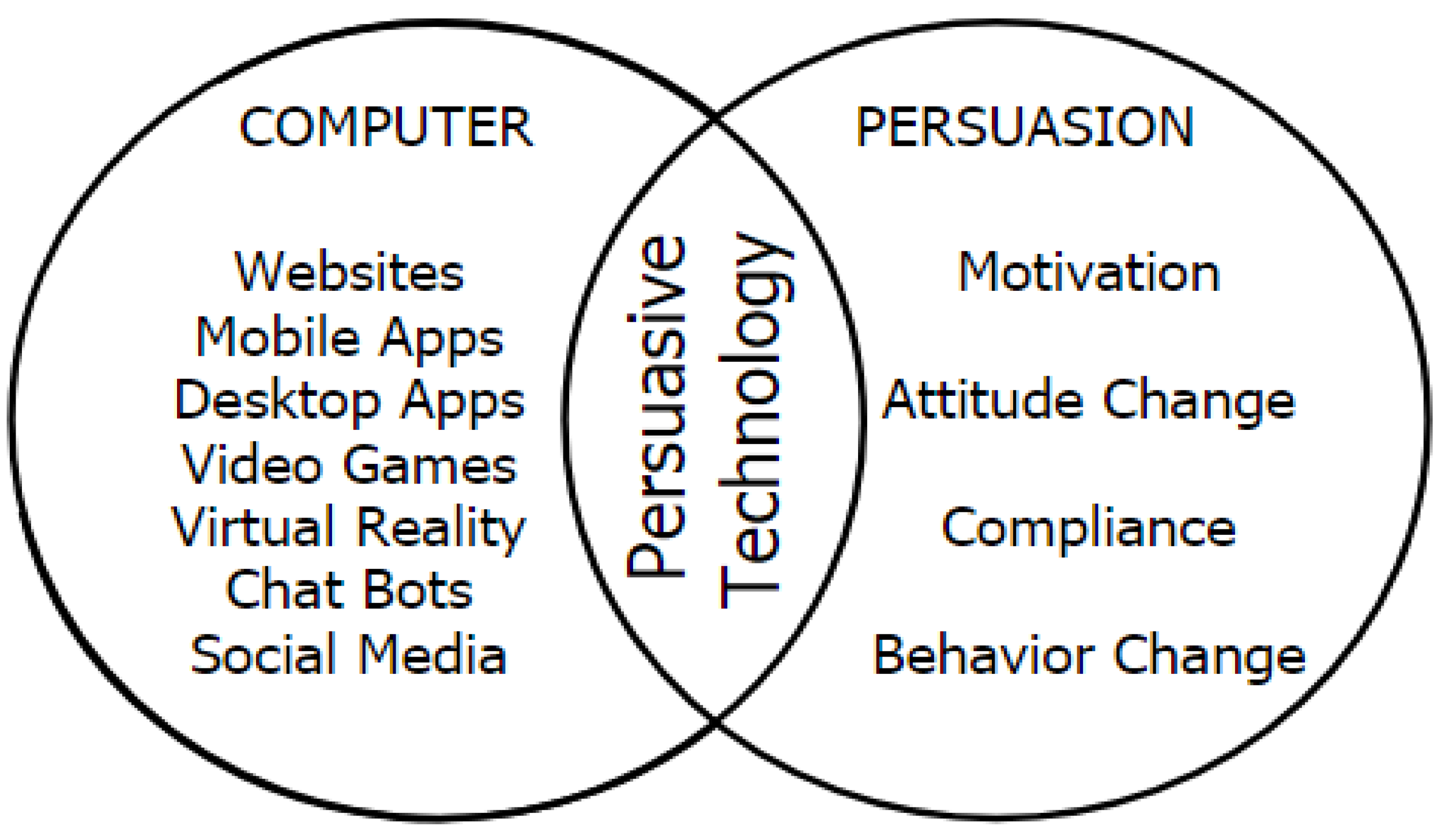
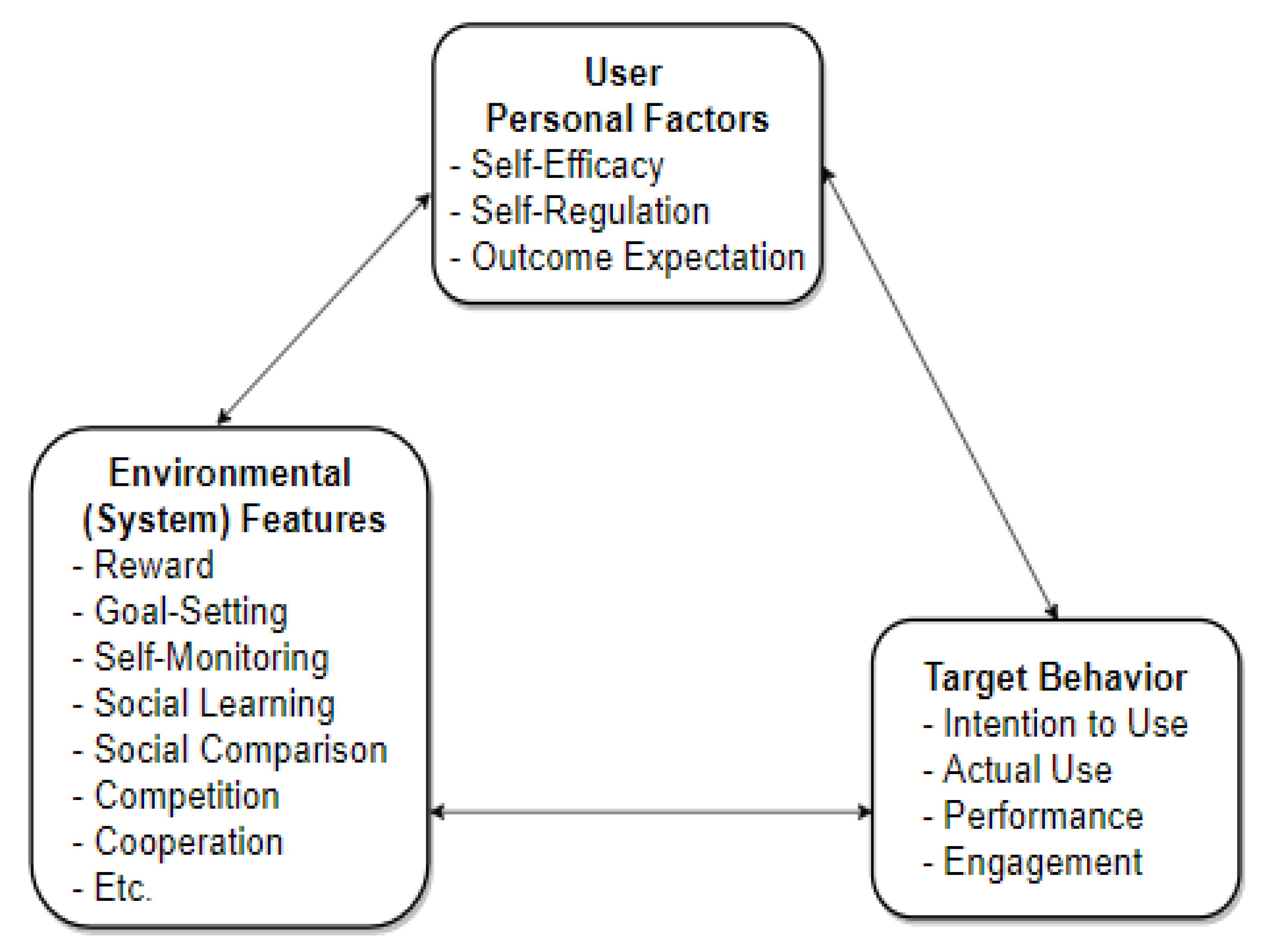
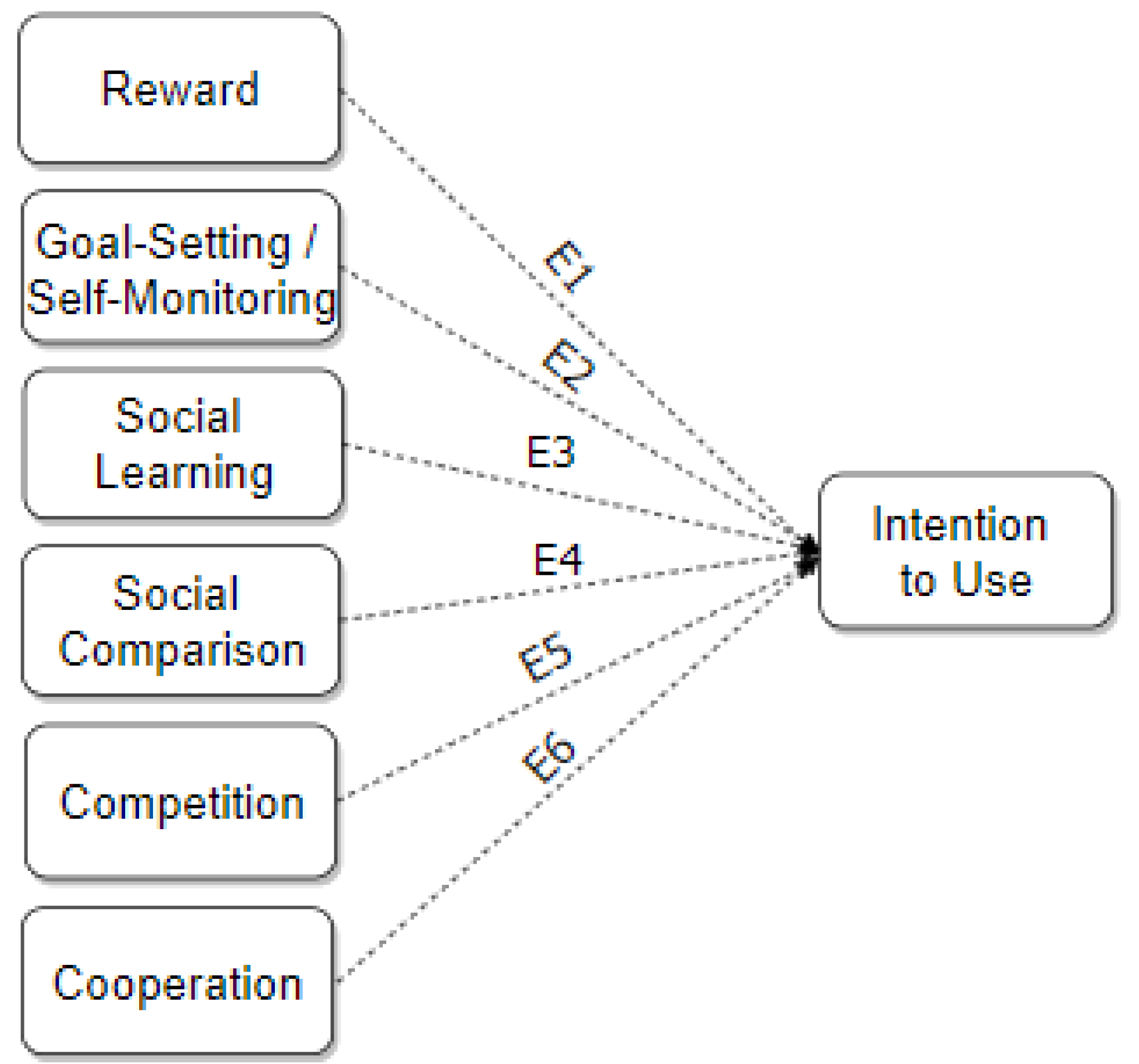

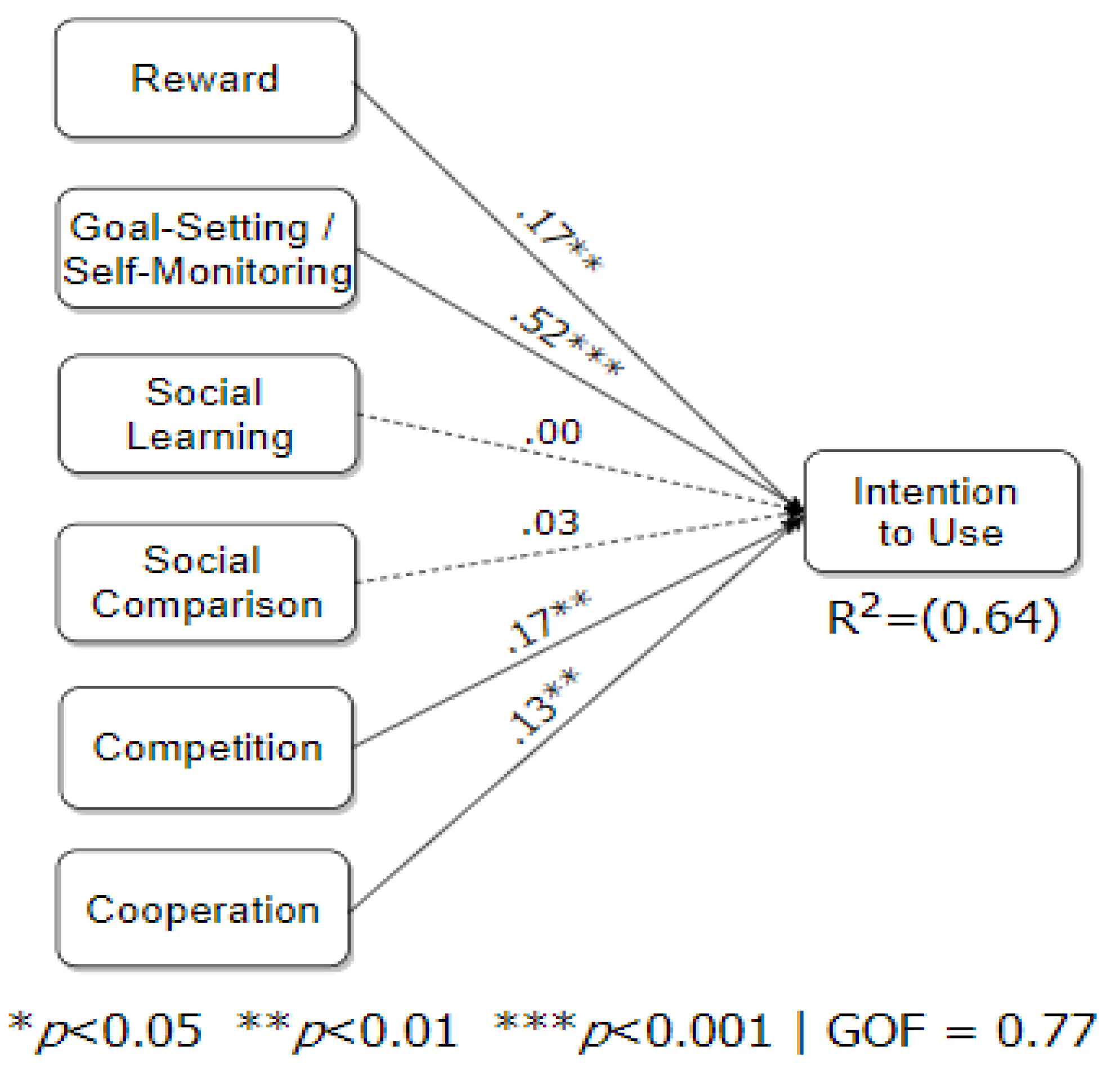
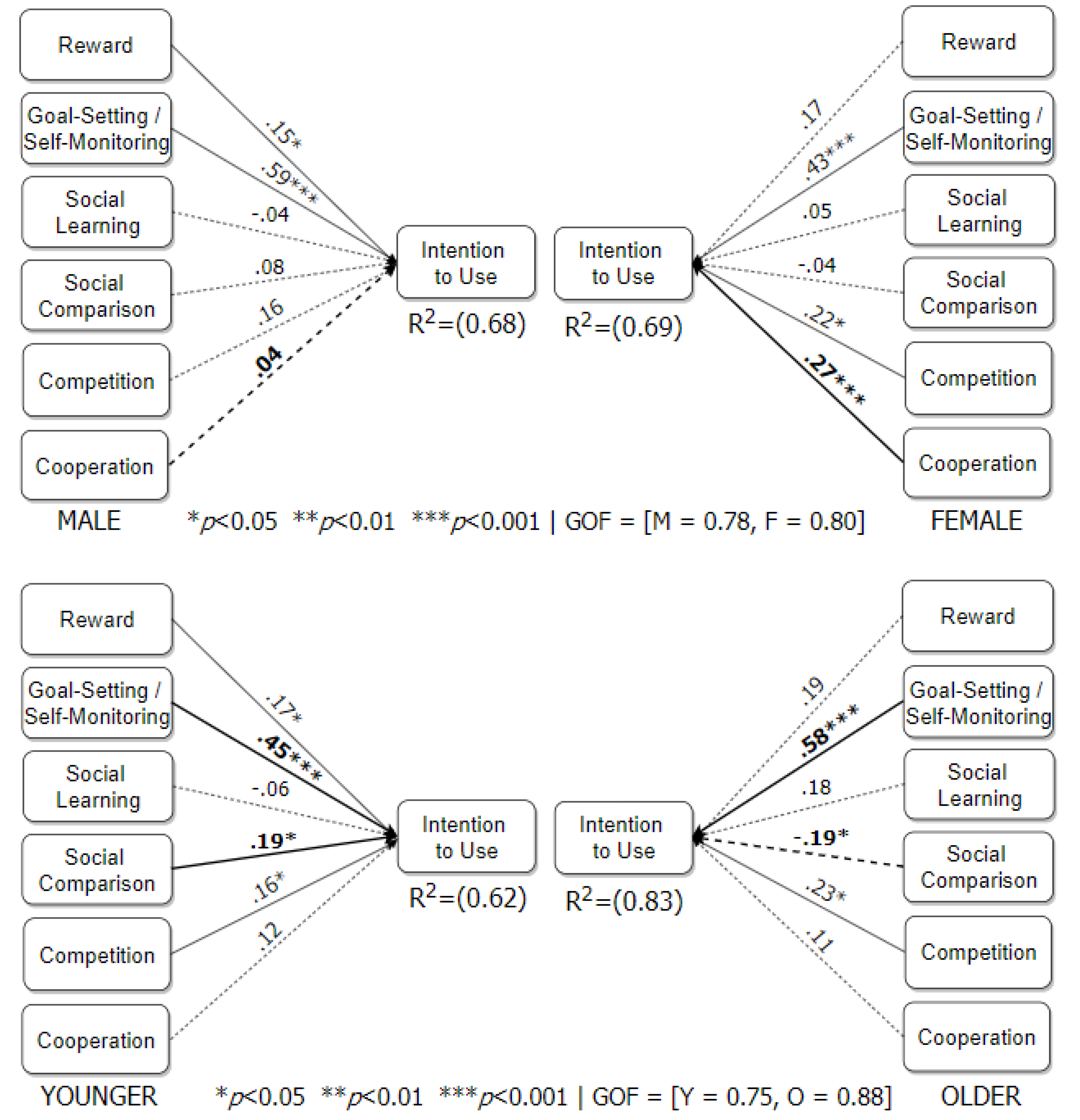
| Feature | Definition of Feature |
|---|---|
| Goal-Setting/Self-Monitoring | A persuasive feature that allows users to set goals and track their performance over time. |
| Reward | A persuasive feature that allows incentives to be awarded to users for the accomplishment of their goal. |
| Cooperation | A persuasive feature that allows users to work together to achieve a collective goal and reward upon reaching their goal. |
| Competition | A persuasive feature that allows users with a common goal and mutually exclusive reward to compete with one another to attain them. |
| Social Comparison | A persuasive feature that allows users to view and compare their performance and achievements with those of others. |
| Social Learning | A persuasive feature that allows users to observe the behaviors and achievements of other users and respond accordingly. |
| Criterion | Overall Question and Items |
|---|---|
| Perceived Feature [23] | Imagine that you are using the Homex App presented in the storyboard above to track your physical activity, to what extent do you agree with the following statements: 1. This feature of the app would influence me. 2. This feature of the app would be convincing. 3. This feature of the app would be personally relevant to me. 4. This feature of the app would make me reconsider my physical activity. 5. Provide comments about this application feature [persuasive strategy illustrated on the storyboard] to justify your rating here [textbox]. |
| Intention to Use | Assuming the app, together with the various features, described earlier on, would be available to me, I predict that I will use it. |
| Variable | Subgroup | Number | Percent |
|---|---|---|---|
| Male | 132 | 57.9 | |
| Gender | Female | 95 | 41.7 |
| Others | 1 | 0.4 | |
| Age | 18–24 | 38 | 16.7 |
| 25–34 | 122 | 53.5 | |
| 35–34 | 45 | 19.7 | |
| 45–54 | 16 | 7.0 | |
| 54+ | 7 | 3.1 | |
| Education | Technical/Trade School | 31 | 13.6 |
| High School | 39 | 17.1 | |
| BSc | 107 | 46.9 | |
| MSc | 33 | 14.5 | |
| PhD | 6 | 2.6 | |
| Others | 2 | 0.9 | |
| Country of Origin | Canada | 89 | 39.0 |
| United States | 98 | 43.0 | |
| Others | 41 | 18.0 | |
| Continent of Origin | North America | 164 | 71.9 |
| South America | 10 | 4.4 | |
| Europe | 13 | 5.7 | |
| Africa | 11 | 4.8 | |
| Asia | 13 | 5.7 | |
| Middle East | 5 | 2.2 | |
| Others | 2 | 0.9 |
| No. | Participants’ Comments | Profile | Remark (PF, ITU) |
|---|---|---|---|
| P23 | “I like the idea because it clearly tracks your calories which I usually wouldn’t consider while doing exercise.” | [GST/SMT = 7, ITU = 6] | (High, High) |
| P26 | “I just don’t think I could live up to the goals and that would depress me.” | [GST/SMT = 2, ITU = 1] | (Low, Low) |
| P39 | “Rewards often convince me to log into apps…” | [REWD = 5, ITU = 6] | (High, High) |
| P05 | “I am exercising because I like it; I don’t need points rewards.” | [REWD = 1, ITU = 1] | (Low, Low) |
| No. | Participants’ Comments | Profile | Remark (SF, ITU) |
|---|---|---|---|
| P69 | “This would motivate and influence me to push harder every day to achieve the top rank (or attempt to) therefore this level of competition does indeed convince influence motivate me and is directly relevant to myself.” | [CMPT = 6, ITU = 5] | (High, High) |
| P127 | “I’m not the competitive type. I don’t do things to be better than others.” | [CMPT = 1, ITU = 1] | (Low, Low) |
| P44 | “Having someone else depending on my activity to gain rewards would influence me to meet my goal.” | [COOP = 6.75, ITU = 7] | (High, High) |
| P92 | “I don’t want to depend on others, and I don’t want to impose on others to do exercise.” | [COOP = 1, ITU = 2] | (Low, Low) |
| No. | Age | Participants’ Comments | Profile | Remark (SF, ITU) |
|---|---|---|---|---|
| P12 | 18–24 | “Similar to competitive leader boards being able to compare yourself to friends for a nice push is great.” | [SCOMP = 5, ITU = 6] | (High, High) |
| P127 | 25–34 | “I don’t like comparison/competition.” | [SCOMP = 1, ITU = 1] | (Low, Low) |
| P19 | 35–44 | “Comparing myself to others can be harmful and demotivating. Someone always loses.” | [SCOMP = 1, ITU = 6] | (Low, High) |
| P58 | 35–44 | “If I can see the results of other people in the group and everybody except me was successful it would make me try harder in the future. I would put more effort into reaching my goal in order to keep up with the others.” | [SCOMP = 6.25, ITU = 1] | (High, Low) |
| P06 | 54+ | “Not interested keep my goals personal.” | [SCOMP = 2, ITU = 5] | (Low, High) |
| Relationship | Global | Male | Female | Young | Old |
|---|---|---|---|---|---|
| Reward | ✔ | ✔ | × | ✔ | × |
| Goal-Setting/Self-Monitoring | ✔ | ✔ | ✔ | ✔ | ✔ |
| Cooperation | ✔ | × | ✔ | × | × |
| Competition | ✔ | × | ✔ | ✔ | ✔ |
| Social Comparison | × | × | × | ✔ | − |
| Social Learning | × | × | × | × | × |
© 2020 by the authors. Licensee MDPI, Basel, Switzerland. This article is an open access article distributed under the terms and conditions of the Creative Commons Attribution (CC BY) license (http://creativecommons.org/licenses/by/4.0/).
Share and Cite
Oyibo, K.; Vassileva, J. Persuasive Features that Drive the Adoption of a Fitness Application and the Moderating Effect of Age and Gender. Multimodal Technol. Interact. 2020, 4, 17. https://doi.org/10.3390/mti4020017
Oyibo K, Vassileva J. Persuasive Features that Drive the Adoption of a Fitness Application and the Moderating Effect of Age and Gender. Multimodal Technologies and Interaction. 2020; 4(2):17. https://doi.org/10.3390/mti4020017
Chicago/Turabian StyleOyibo, Kiemute, and Julita Vassileva. 2020. "Persuasive Features that Drive the Adoption of a Fitness Application and the Moderating Effect of Age and Gender" Multimodal Technologies and Interaction 4, no. 2: 17. https://doi.org/10.3390/mti4020017
APA StyleOyibo, K., & Vassileva, J. (2020). Persuasive Features that Drive the Adoption of a Fitness Application and the Moderating Effect of Age and Gender. Multimodal Technologies and Interaction, 4(2), 17. https://doi.org/10.3390/mti4020017





